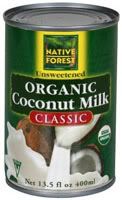. . . and the Methodical Pantry Expansion Method
- Typical Complaint: “I’m so tired of making the same old things for dinner.”
- Response: Stock a few new and interesting pantry treasures to spark up mealtimes.
- Counter-complaint: “But when I buy something new, it gets used for only one dish and then it just sits in the cupboard.”
Faced with this Catch 22, many people just give up and make the same old boring things, over and over.
Tired of this ending? If so try the Methodical Pantry Expansion Method: After buying and using a new ingredient for one recipe, don’t let it migrate into the forgotten corners of the pantry. Make a conscious effort to journey further with it! Find other uses for it, then put it to use and gain a feel for and familiarity with it. Pretty soon, you’ll be using it as easily and naturally as onion and garlic.
Here’s an example for coconut milk from the first Whole Kitchen Cooking Series:
- First we used coconut milk for an Asian Style Creamy Asparagus Soup

- Two weeks later, we used coconut milk for Saag Paneer (an Indian creamed spinach)
- A week later, we found that coconut milk made a delightful addition to tapioca pudding.
- A couple days after the series, with leftover coconut milk sitting in my frig, I created this month’s Creamy Gingered Pea and White Fish recipe for the class.
No Catch 22 here. Just lots of interesting dishes with no waste, and class members began acquiring an ease and comfort using coconut milk.
I certainly didn’t start out with any ease or comfort using coconut milk. In fact, I sputtered and nearly stalled several times, as cans of coconut milk accumulated and sat idle in the pantry. Finally I realized that new pantry ingredients don’t become helpful, boredom-busting friends without conscious and methodical (but not at all difficult) effort. Hence:
The Methodical Pantry Expansion Method
- First, find a recipe that features one or two intriguing new pantry ingredient(s.)
- Focus on less expensive ingredients when learning the process.
- For the first couple purchases, opt for small amounts over larger or bulk buys.
- For more expensive items, try to taste in a class or demo before committing to a purchase. Or go in with a friend.
- Test the new ingredient in an initial recipe, but–here’s the critical point–don’t stop with just one try. Get busy and try it a couple more times, bearing in mind that it might take a few tries to fully appreciate a new flavor.
- Now keep an eye out for more recipes with your new ingredient. This will happen with surprising frequency. Looking for particular recipes has a way of drawing them out of the woodwork, as I explained in the post on recipes with targeted spices.
Doing this much may be all the farther you go. You discover three or four favorite recipes and move on to another new find. But you may also come to a point where ad libbing seems appropriate. All of a sudden, you have enough of a feel for and familiarity with an ingredient that spontaneous uses break forth: “Hmmm . . . I’ve got a great curry here, but it’s a little too spicy. What if I add a dollop of coconut milk to smooth it out?”
I was a year or two into following Thai recipes when I suddenly began mixing and matching Thai seasonings on my own, with delicious results. At the outset, of course, I didn’t ever think I could throw together a dish with things like fish sauce, chili paste and lemongrass. But time and experimenting does indeed make tinkering possible–and really fun. It’s at this point of “creative convergence” that cooking leaves the realm of “tiresome chore” and enters the realm of “enjoyable and engaging.” I hope you’ll experiment and experience it.

Want to make coconut milk your new ingredient? Checkout the next post for tips on using and storing coconut milk. And don’t forget this month’s recipe for Creamy Gingered Pea and White Fish.
2 thoughts on “Pantry Stocking: Coconut Milk, Catch 22s . . .”